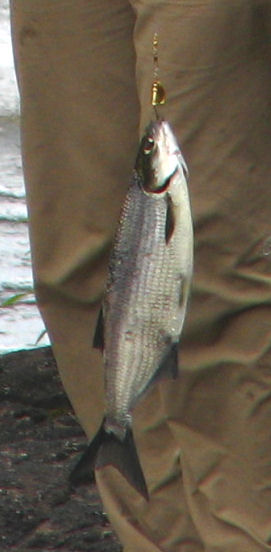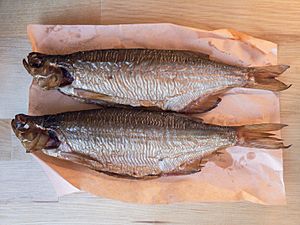Goldeye facts for kids
Quick facts for kids Goldeye |
|
|---|---|
 |
|
| Conservation status | |
| Scientific classification | |
| Synonyms | |
|
List
|
The goldeye is a cool freshwater fish. You can find it in Canada and the northern United States. It's one of only two types of fish left in its family, called Hiodontidae. The other one is the mooneye. The name alosoides means it looks a bit like a shad fish. People also call it the Winnipeg goldeye, western goldeye, or yellow herring. In French, it's known as laquaiche aux yeux d’or, which means "golden-eyed laquaiche."
Contents
What Goldeyes Look Like
Goldeyes are easy to spot because of their shiny silver bodies and big, golden eyes. From above, they look blue-green and silver. From below, they are more white-silver.
They have several fins:
- Two fins on their belly (abdominal and pelvic fins).
- One fin on their back (dorsal fin).
- One fin on their underside (anal fin).
The fin on their back is usually right above or behind the fin on their underside. Goldeyes also have a special fleshy ridge that runs along their belly. Their mouth is large and at the very front of their head, with a rounded snout. They have smooth scales without any spines. Goldeyes also have a special sensing system called the lateral line system. This helps them feel vibrations in the water.
Adult goldeyes are usually about 15 to 17 inches long. Some can even grow up to 20 inches! They typically weigh only 1 to 2 pounds.
Goldeye Reproduction
Female goldeyes are ready to have babies when they are about 7 to 10 years old. Males are ready a bit earlier, at 6 to 9 years old. They lay their eggs in late May or early June.
Their eggs are about 4 millimeters big. What's special about these eggs is that they are semi-buoyant. This means they float in the middle of the water, not sinking to the bottom or floating on top. This is rare for freshwater fish but common for ocean fish. The eggs drift downstream or into calm, quiet waters. Most of the baby goldeyes grow a lot between June and September.
Where Goldeyes Live
Goldeyes live in many places across North America. You can find them as far north as Aklavik in the Mackenzie River area. They live as far south as the Mississippi River. To the west, they are in Alberta, and to the east, they reach Ohio (south of the Great Lakes). There's also a small group living south of James Bay.
These fish prefer water that is a bit cloudy and moves slowly. They like both lakes and rivers.
What Goldeyes Eat
Goldeyes are not picky eaters! They munch on many different things, including:
- Insects
- Crustaceans (like small shrimp or crabs)
- Other small fish
- Even small frogs
While most goldeyes are less than 1 pound and 12 inches long, some in certain lakes can grow up to 2 pounds or 16 inches. The longest one ever reported was 52 centimeters (about 20 inches)!
Fishing for Goldeyes
Goldeyes are considered good for fly-fishing. However, they are not super popular with most anglers because of their small size. The famous explorers Lewis and Clark even wrote about them!
People started fishing for goldeyes to sell them as early as 1876. Fresh goldeye meat is quite soft and not very appealing. Because of this, they used to be caught by accident in nets and sometimes sold as dog food.
But today, many people love to eat goldeyes when they are smoked. Commercial fishermen often prepare them by soaking them in a special salty mix (called brine) with spices, brown sugar, and other secret ingredients. Then, they smoke the fish using wood from oak, apple, or other trees. Each producer has their own special way of smoking them. Even though the fresh meat is soft, you can soak a goldeye in salt water for a day and then poach it. This makes the meat much firmer.
The idea of selling smoked goldeye as a popular food came from Robert Firth. He moved to Winnipeg, Manitoba from Hull, England, in 1886. He was already selling some cold-smoked goldeye. One day, he made a mistake with the heat in his smoker. This accident led him to discover the now-famous way of hot-smoking the whole fish!
The bright red or orange color of smoked goldeye used to come from using only willow wood smoke. But today, a special dye is often used to get that color. Smoked goldeye became a fancy dish after 1911. Even famous people like Woodrow Wilson (a US President) and the Prince of Wales enjoyed it!
For a few years, from 1926 to 1929, over a million pounds of goldeye were caught each year. But after 1931, there were fewer fish, and not many were caught from Lake Winnipeg after 1938. Today, a small amount of commercially caught goldeye is sent to the United States, but most of it is eaten in Canada. Even though Lake Winnipeg used to be the main place to catch them, most goldeyes now come from places like Saskatchewan and Alberta. However, the name Winnipeg goldeye is still used because Winnipeg is where they are processed and prepared.
The goldeye fish is so important to Winnipeg that the city's minor league baseball team is called the Winnipeg Goldeyes!



